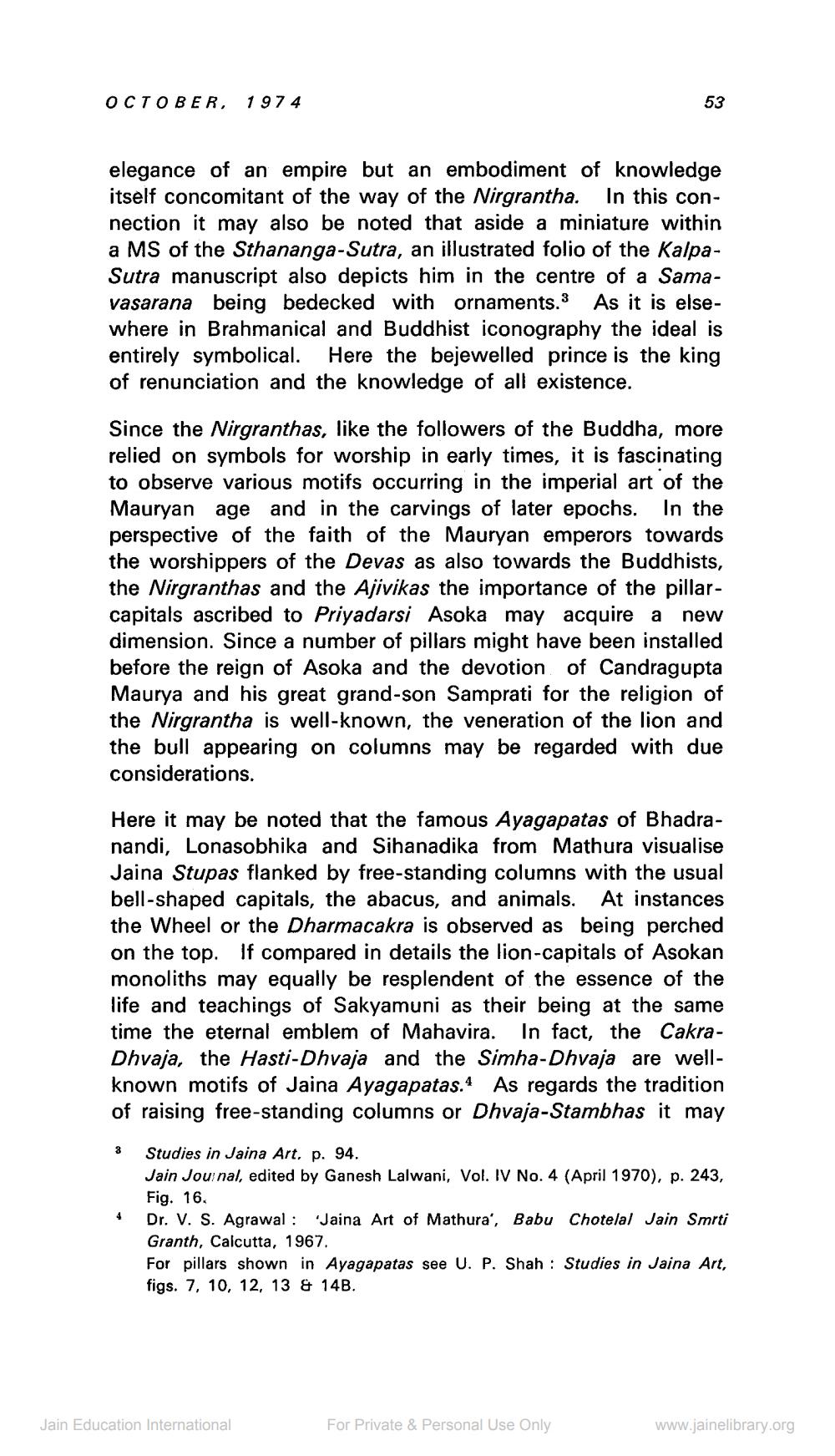Book Title: Jain Journal 1974 10 Author(s): Jain Bhawan Publication Publisher: Jain Bhawan Publication View full book textPage 5
________________ OCTOBER, 1974 elegance of an empire but an embodiment of knowledge itself concomitant of the way of the Nirgrantha. In this connection it may also be noted that aside a miniature within a MS of the Sthananga-Sutra, an illustrated folio of the KalpaSutra manuscript also depicts him in the centre of a Samavasarana being bedecked with ornaments.3 As it is elsewhere in Brahmanical and Buddhist iconography the ideal is entirely symbolical. Here the bejewelled prince is the king of renunciation and the knowledge of all existence. 53 Since the Nirgranthas, like the followers of the Buddha, more relied on symbols for worship in early times, it is fascinating to observe various motifs occurring in the imperial art of the Mauryan age and in the carvings of later epochs. In the perspective of the faith of the Mauryan emperors towards the worshippers of the Devas as also towards the Buddhists, the Nirgranthas and the Ajivikas the importance of the pillarcapitals ascribed to Priyadarsi Asoka may acquire a new dimension. Since a number of pillars might have been installed before the reign of Asoka and the devotion of Candragupta Maurya and his great grand-son Samprati for the religion of the Nirgrantha is well-known, the veneration of the lion and the bull appearing on columns may be regarded with due considerations. Here it may be noted that the famous Ayagapatas of Bhadranandi, Lonasobhika and Sihanadika from Mathura visualise Jaina Stupas flanked by free-standing columns with the usual bell-shaped capitals, the abacus, and animals. At instances the Wheel or the Dharmacakra is observed as being perched on the top. If compared in details the lion-capitals of Asokan monoliths may equally be resplendent of the essence of the life and teachings of Sakyamuni as their being at the same time the eternal emblem of Mahavira. In fact, the CakraDhvaja, the Hasti-Dhvaja and the Simha-Dhvaja are wellknown motifs of Jaina Ayagapatas. As regards the tradition of raising free-standing columns or Dhvaja-Stambhas it may 3 Studies in Jaina Art, p. 94. Jain Journal, edited by Ganesh Lalwani, Vol. IV No. 4 (April 1970), p. 243, Fig. 16. 4 Dr. V. S. Agrawal : 'Jaina Art of Mathura', Babu Chotelal Jain Smrti Granth, Calcutta, 1967. For pillars shown in Ayagapatas see U. P. Shah Studies in Jaina Art, figs. 7, 10, 12, 13 & 14B. Jain Education International For Private & Personal Use Only www.jainelibrary.orgPage Navigation
1 ... 3 4 5 6 7 8 9 10 11 12 13 14 15 16 17 18 19 20 21 22 23 24 25 26 27 28 29 30 31 32 33 34 35 36 37 38 39 40 41 42 43 44 45 46 47 48 49 50 51 52 ... 54
